While StarCraft: Remastered seems to be pretty well regarded, not all of Blizzard’s efforts to rejuvenate their older games have been so successful. With that in mind, I was highly skeptical of Diablo II: Resurrected. It was only after hearing great things about the title from some trusted podcasters that I decided to check it out, and even then it was kind of a random, impulsive install. Regardless, I found myself getting hooked by the gameplay and story despite having played through it so many times before.
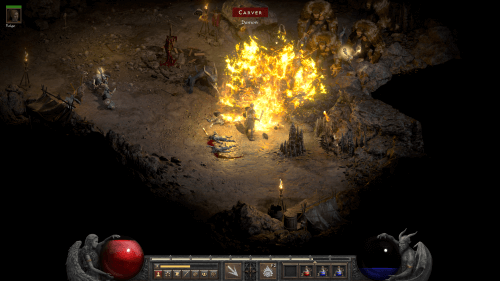
“Playing a fire build was a good choice with this new lighting engine.”
In short, this remastered version looks, sounds, and plays exactly how you probably remember it from back in 2000 and 2001, but the ability to dynamically toggle the graphics between the old and the new really shows just how faulty our memories can be. Knowing that the game was remastered had me engaged, trying to spot little changes and differences, and likely mistaking a lot of things I’d simply long forgotten as enhancements. I got so hooked, I ended up buying it for my Xbox Series X as well to give playing with with a controller a spin, utilizing the cross-save feature to swap between platforms whenever my mood demanded it. I didn’t play much further than the first act, but I was very impressed by the craftsmanship put into this new version, and while most of the potential to modernize some of the more dated features was skipped in favor of staying faithful to the original game, it’s hard to fault that. I’ll return to Diablo II: Resurrected one of these days, but the main reason I bailed so early was because I knew more exciting things were on the horizon.
I didn’t pay much attention to Diablo IV until relatively close to its release, when I started hearing positive things from those lucky enough to try the game during preview events. Blizzard had a couple of “server slam” stress test weekends a few months before release, and I managed to get into the very last one and try the game out for a few hours myself. I preordered the game shortly after that. That’s how much I enjoyed it.
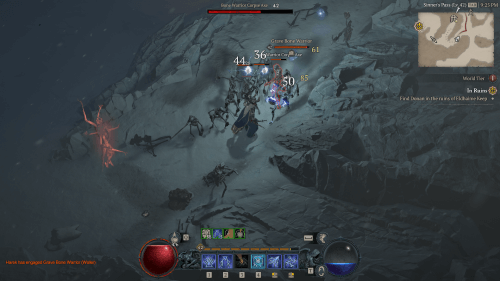
“Fending off a horde of skeletons.”
Diablo IV feels, in many ways, like a love letter to Diablo II. Something of a “what if” scenario where Diablo III never happened, and the team that made Diablo II and Lord of Destruction immediately dove into developing a sequel, only after the entire studio was somehow transported 20 years into the future. This has positive and negative connotations. On the positive side, the game is an absolute return to the dark, moody tone of Diablo II. While maybe slightly less bleak, it pulls no punches in terms of showing the grim and gory world of a Sanctuary under the influence of evil: you’ll find far more corpses laying around randomly, piled in stacks, hanging from trees, and impaled on spikes than living NPCs, for example. This is also reflected in the graphical style, which resembles the 2D pixel art of Diablo II far more than the more stylized, simpler 3D models of Diablo III. The series’ sound design and particularly its music has always been consistent with what was established with the original Diablo, and Diablo IV feels continues this trend with a lot of direct throwbacks to those classic sound effects and compositions.
While I have seen the odd accusation of the game looking dated, I suspect that this is largely a side effect of trying to translate Diablo II’s look into 3D. I’m a fan. Besides the underwhelming character creator, my only nitpick is that I wish I could zoom the camera out just a tiny bit more, and we know it’s possible as many of the game’s cool in-engine cutscenes play with the camera, sometimes leaving it zoomed out further than normal. The prerendered cutscenes are absolutely amazing too, but we expect nothing less from Blizzard at this point. The aforementioned sound and especially music are masterfully executed as well. One of my telltale signs that a game has good music is when I actually notice it and stop to enjoy it, which I did more than once during my playthrough of Diablo IV’s campaign. So, that’s all good then, what about the story?
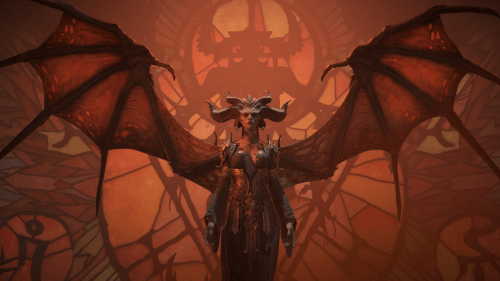
“I admit it, I kind of love Lilith.”
As a random wanderer, your character stumbles across a village that has been recently taken over by the influence of the demon Lilith. You soon meet up with some allies and the investigation of Lilith’s plot, with the eventual goal of stopping her entirely, guides the rest of your adventure. Lilith is very interesting antagonist in that, unlike your usual demonic invaders, while sure, there’s definitely an evil corruption at play, her charisma and the dogma she imparts seems to do just as much of the heavy lifting as she builds a following of humans rather than the usual shtick of simply wanting to wipe them out. In fact, she claims to want to save Sanctuary from further destruction by the machinations of and conflict between Heaven and Hell. Of course, that would mean her coming out on top, and who knows at what cost, so perhaps she’s actually just full of shit, but I like that she always comes across as a little sympathetic, and her true nature is always left at least a little ambiguous. I also loved the concept of the angel Inarius, banished to Sanctuary where a religion forms around him. In a twist to fans of the previous games, Inarius is not really an ally to your character in any real sense, and while he’s an important part of the story (particularly the backstory) he’s barely featured. Neat stuff, though the way it all wraps up comes about as close to begging for an expansion or at least a proper sequel as you can get without the story feeling unfinished.
Diablo IV also all but pretends that many of the revelations that came from Diablo III’s story didn’t happen. I don’t believe there was a single mention of Nephalem, for instance. In fact, the only real connections I picked up on (although, it has been quite a few years since playing Diablo III) were the now rather old Horadrim Lorath, and the fact that the Horadrim (and Sanctuary at large) feels particularly devastated, which makes sense after the events of Diablo III’s Reaper of Souls expansion. I could imagine this confusing if not disappointing a lot of Diablo III fans, though I for one prefer the much more serious tone of Diablo II and Diablo IV to the more fantastical, and at times flat out silly, writing of Diablo III.
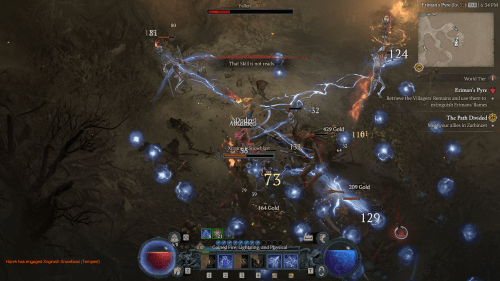
“Lightning Sorcs can make quite a mess.”
Mechanically, Diablo IV does very little to build off of the systems that appeared in Diablo III, feeling in some ways like a bit of a step backwards. Your character feels a bit weaker and the action tends to feel a bit slower than the utter murder fests that fights in Diablo III would turn into. Skill progression is similarly old school, as you pick a number of abilities, both active and passive, from a fairly large tree, versus Diablo III’s much more stripped down progression system where you’d pick from a small selection of active abilities and apply a single modifier to them. The endgame “paragon” system does make a return from Diablo III, but is similarly much more complex. Naturally, some people will prefer Diablo III after so many years of live iteration, and some will be taken aback by Diablo IV’s slightly regressive mechanics. Personally, thanks to giving us just enough quality of life enhancements and overall polish, I think it works well. My only real gripe is that progression tends to be a bit front loaded, and by the time you near level 50, you’ll mostly be spending all of your points on relatively boring passive abilities, and after that you’ll progress to the aforementioned similarly boring and definitely more than a little convoluted paragon system.
Gear progression is in a similar boat. Diablo IV’s legendary items have “aspects” which can often have a major impact on the behavior of core class abilities, but I find myself missing some of Diablo III’s wacky, sometimes overpowered legendary weapon effects. There are a thousand other differences, as well as some Diablo II mechanics that didn’t make it in (like runes and rune words, despite there being a gem socketing system) but I suspect there’s a good chance of many of them showing up in the inevitable expansion. Not being one of those hardcore players who has sunk thousands of hours into the endgames of previous Diablo games, I don’t think I want to go too much more in-depth about the mechanics. That is to say, there are definitely better qualified people than me to provide this kind of analysis.
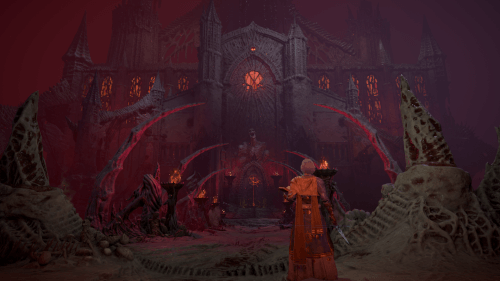
“Welcome to the Burning Hells.”
Perhaps the biggest change a casual player will notice is that Diablo’s world map is now completely open, sprawling, and filled with side content. The size and openness of the world doesn’t actually impact things too much, as the campaign questline will inevitably lead you through various regions and some of their sub-zones in a similar, albeit less linear fashion as the previous games did, and traveling isn’t too much of a chore thanks to the all too familiar system of waypoints (and when you get a horse later on, even less so.) No, the biggest issue I have with the open-world is the huge amount of side quests, dungeons, and other distractions you’ll run into in your journey. On one hand, I appreciate the content, but on the other hand, trying to complete every quest you come across and clear every dungeon you see is going to seriously derail your campaign progress. I started playing the campaign at the same time as a few colleagues of mine, and even when our playtimes were similar, I noticed I was well behind them in the campaign. It was the damn side quests! Once I started totally ignoring them and focusing exclusively on campaign quests, the game stopped feeling like so much of a slog, and I was able to dig myself out of the burnout that was setting in.
I should make a quick mention of another major change while talking about Diablo IV’s more open-world nature. The game is now something of an MMO in that you’ll run across other players in the world while playing. If you’re asocial, you shouldn’t let this concern you, as I rarely ran across anyone outside of the major cities, and even when I did, we’d almost always ignore each other and go our separate ways. There are “events” across the map (more or less the “public quest” system introduced in Warhammer Online) which work best when tackled cooperatively, but these are the only times I really played with random players. Even still though, I personally enjoy seeing other players in the world, and the opportunity for casual co-op play, random chat, and the like is pretty cool, never mind being able to fairly seamlessly play with your actual friends when you want to. I just wish this was an optional feature for those who’d rather (or can’t) always play online.
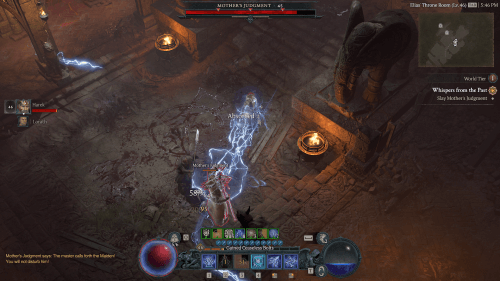
“Lorath and I unloading.”
I’ve personally never been even a little enamored by Diablo’s endgame. In the original game, it was grinding for better items, sometimes with friends, and of course PKing and otherwise griefing other players. In Diablo II, it meant running through the campaign multiple times with increasing difficulty until focusing on that brutally repetitive Act V item grind, trying to find the best unique equipment, set items, and runes. Diablo III did a good job of trying to make this less of a repetitive grind by introducing “Adventure Mode” which would give players random quests to go slap a series of enemies, and rifts, which were randomly generated dungeons. Diablo IV leverages its open-world for its endgame. Since enemies are always scaled, all of that content you may have skimmed over while playing the campaign is available to grind through, as are the Tree of Whispers random quests, Helltide events, world bosses, and a number of other challenges and collect-a-thons. There’s a lot to do, although it’s a tiny bit of a bummer that so much less of the game is randomized now given that it was such a notable element of Diablo’s roguelike origins. Regardless, at the end of the day, all of these iterations come down to one thing: fairly pointless grinding. No offense to anyone who enjoys it, of course, but It’s amazing to me that Blizzard would focus so much on an endgame which is going to be so unappealing to most people. *shrug*
That’s worth mentioning, because it seems that certain types of games are judged largely by a hardcore, vocal minority of endgame players, and yet I can really like a World of Warcraft expansion, for example, based solely on its campaign and the gameplay changes I experienced therein, regardless of the raiding community thinking it’s the worst expansion to date. Diablo IV’s endgame is just one of the many popular topics that commonly pops up in criticisms of the game. It’s bizarre to me how divisive of a title Diablo IV is. Some of it, like the ridiculous cosmetics store, ham-fisted nerfs around the season 1 patch, and how slow Blizzard has been to address certain things, is legitimate, but pop into any comment or discussion thread about the game, and you’ll see a lot of people spouting absolutely ludicrous, objectively untrue nonsense about it. I guess there are tons of people always primed and ready to hate on anything Blizzard produces these days. Shame that, because while I certainly don’t believe it succeeds in taking Diablo II’s crown, I really did enjoy my time with it and will definitely be dusting it off again in the future.